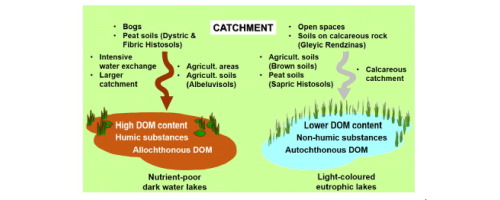当前位置:
X-MOL 学术
›
J. Hydrol.
›
论文详情
Our official English website, www.x-mol.net, welcomes your
feedback! (Note: you will need to create a separate account there.)
The role of catchment soils and land cover on dissolved organic matter (DOM) properties in temperate lakes
Journal of Hydrology ( IF 5.9 ) Pub Date : 2019-03-01 , DOI: 10.1016/j.jhydrol.2019.01.012 Margot Sepp , Toomas Kõiv , Peeter Nõges , Tiina Nõges
Journal of Hydrology ( IF 5.9 ) Pub Date : 2019-03-01 , DOI: 10.1016/j.jhydrol.2019.01.012 Margot Sepp , Toomas Kõiv , Peeter Nõges , Tiina Nõges

|
Abstract Dissolved organic matter (DOM) is a critical component in freshwater ecosystem functioning. The main sources of DOM in lakes are allochthonous inputs from the catchment and autochthonous in-lake production. This study focused on the role of catchment characteristics on the qualitative and quantitative properties of DOM in small temperate lakes along a gradient of alkalinity. We examined DOM properties based on the optical absorbance and fluorescence measurements of water from 34 Estonian lakes. The content and composition of DOM were highly diverse in the lakes studied, e.g. the dissolved organic carbon (DOC) concentrations varied from 3.2 to 53.0 mg L−1. Land cover, soil, and catchment hydrology and geology had substantial effects on DOM in lakes. Stock of soil organic carbon (SOC) in the catchment and water exchange rate (a descriptor of catchment hydrology, reciprocal of water residence time) had major positive effects on DOC concentrations. The aromaticity and molecular weight of DOM, i.e. the relative abundance of humic substances, and the dominance of allochthonous DOM increased with the drainage ratio (catchment area/lake area) and the percentages of bogs, and Dystric and Fibric Histosols (peat soils in transitional mires and bogs, respectively) in the catchments. Dominance of non-humic over humic substances and autochthonous over allochthonous DOM in lakes corresponded to calcareous catchments and higher percentages of Gleyic Rendzinas (thin soils on calcareous rock), Sapric Histosols (peat soils in mires) and open spaces (areas with little vegetation). Our results showed that soil variables had in general a greater effect than land cover and were more informative for describing the role of catchment characteristics on DOM in lakes. Patterns in DOM quantity and quality found in our study were similar to patterns found in other temperate lakes; therefore, our results have important implications for understanding catchment-lake interactions across the temperate region.
中文翻译:

集水土壤和土地覆盖对温带湖泊溶解有机质 (DOM) 特性的作用
摘要 溶解有机物 (DOM) 是淡水生态系统功能的重要组成部分。湖泊中 DOM 的主要来源是来自集水区和本地湖内生产的外来输入。本研究侧重于流域特征对沿碱度梯度的温带小湖泊中 DOM 的定性和定量特性的作用。我们根据来自 34 个爱沙尼亚湖泊的水的光吸收率和荧光测量结果检查了 DOM 特性。在所研究的湖泊中,DOM 的含量和组成差异很大,例如溶解有机碳 (DOC) 浓度从 3.2 到 53.0 mg L-1 不等。土地覆盖、土壤和集水区水文地质对湖泊中的 DOM 有重大影响。流域中的土壤有机碳 (SOC) 储量和水交换率(流域水文描述,水停留时间的倒数)对 DOC 浓度有主要的积极影响。DOM 的芳香性和分子量,即腐殖质的相对丰度,以及外来 DOM 的优势随着排水比(集水面积/湖泊面积)和沼泽百分比和 Dystric 和 Fibric Histosols(过渡性泥炭土)的增加而增加。沼泽和沼泽)。湖泊中非腐殖质高于腐殖质和本土 DOM 高于外来 DOM 的优势对应于钙质集水区和 Gleyic Rendzinas(石灰质岩石上的薄土壤)、Sapric Histosols(泥炭泥炭土)和开放空间(植被很少的区域)的百分比. 我们的结果表明,土壤变量通常比土地覆盖具有更大的影响,并且在描述集水特征对湖泊中 DOM 的作用方面提供更多信息。我们研究中发现的 DOM 数量和质量模式与其他温带湖泊中发现的模式相似;因此,我们的结果对于理解温带地区的集水湖相互作用具有重要意义。
更新日期:2019-03-01
中文翻译:

集水土壤和土地覆盖对温带湖泊溶解有机质 (DOM) 特性的作用
摘要 溶解有机物 (DOM) 是淡水生态系统功能的重要组成部分。湖泊中 DOM 的主要来源是来自集水区和本地湖内生产的外来输入。本研究侧重于流域特征对沿碱度梯度的温带小湖泊中 DOM 的定性和定量特性的作用。我们根据来自 34 个爱沙尼亚湖泊的水的光吸收率和荧光测量结果检查了 DOM 特性。在所研究的湖泊中,DOM 的含量和组成差异很大,例如溶解有机碳 (DOC) 浓度从 3.2 到 53.0 mg L-1 不等。土地覆盖、土壤和集水区水文地质对湖泊中的 DOM 有重大影响。流域中的土壤有机碳 (SOC) 储量和水交换率(流域水文描述,水停留时间的倒数)对 DOC 浓度有主要的积极影响。DOM 的芳香性和分子量,即腐殖质的相对丰度,以及外来 DOM 的优势随着排水比(集水面积/湖泊面积)和沼泽百分比和 Dystric 和 Fibric Histosols(过渡性泥炭土)的增加而增加。沼泽和沼泽)。湖泊中非腐殖质高于腐殖质和本土 DOM 高于外来 DOM 的优势对应于钙质集水区和 Gleyic Rendzinas(石灰质岩石上的薄土壤)、Sapric Histosols(泥炭泥炭土)和开放空间(植被很少的区域)的百分比. 我们的结果表明,土壤变量通常比土地覆盖具有更大的影响,并且在描述集水特征对湖泊中 DOM 的作用方面提供更多信息。我们研究中发现的 DOM 数量和质量模式与其他温带湖泊中发现的模式相似;因此,我们的结果对于理解温带地区的集水湖相互作用具有重要意义。











































 京公网安备 11010802027423号
京公网安备 11010802027423号